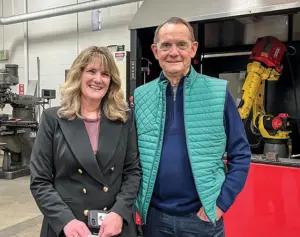Once upon a time, at a small southern Minnesota manufacturer, there was a welder who was content to just weld.
Or so he thought.
He was a great welder, but his company needed more from him. It needed him to be a leader. And even though he didn’t see it, management saw something in him suggesting he had leadership skills.
“There are days where he just wants to keep his head down, get work done, and weld,” says Abbey Hellickson, a business growth consultant for Enterprise Minnesota. “We’ve been working for 12 weeks together and yesterday he says, ‘I really have learned that I can’t just do that anymore. It’s my responsibility to lead the team, plan the work. And if I don’t do that, we don’t have good days.’”
This scenario is familiar to Hellickson, whose latest Enterprise Minnesota presentation takes a deep dive into what she calls the “leadership pipeline.” The tale of the welder illustrates someone going from the bottom level and taking the next step, one that is perhaps the most difficult in the pipeline.
The welder’s realization of the value of welding less and leading more — and how it can ultimately make him more valuable and the company more profitable — represents a crucial point on the pipeline.
“From my perspective, it was kind of the ultimate ‘a-ha’ moment for him,” Hellickson says. “He realized he needed to get out from under the helmet and be able to truly do his job in that lead role.”
The leadership pipeline resembles a ladder. At the bottom is the worker, perhaps a welder, simply doing his job and managing himself. The next rung up involves managing others, a transition Hellickson says can be difficult because it asks someone to do something above and beyond the job they were hired to do.
“Typically, it’s the first time they’ve ever managed people,” Hellickson says. “And in manufacturing environments, they still actually do some of the work themselves. Now they have to manage and lead others, and so the time-management element for them is really challenging. On top of that, they’ve never had to deal with performance issues, the coaching conversations, and the people side — ‘now I have to hold people accountable who I was just eating lunch with yesterday.’”
Learn how Enterprise Minnesota can help you navigate your talent and leadership development programs
The next phase of the pipeline — the next rung up — is a department head. Let’s say our welder gets promoted to operations manager. At this level, the day-to-day work involves a higher thought process and more discussion about strategy. This phase requires little “doing” on the shop floor, and more meeting with department heads to develop strategy and guide the company mission. These leaders must develop communication skills and tools for measuring progress.

The final phase, then, is business leader. Leaders at this level engage in alignment thinking — the idea that every action must point toward an end goal of profit. They focus on maintaining a balance between strategic and operational thinking. Business leaders must coach department heads, or functional leaders, and set the tone for the company’s mission.
“This is about your organizational competencies,” Hellickson says. “What’s our niche? What are we good at? What are we going to focus on? How are we going to be successful today and tomorrow?”
Hellickson says she’s currently working with a business leader who is preparing to strategically pare down the number of products it offers — a business-leader decision about niche and the company’s future.
Developing leaders takes time, and not everyone is cut out to lead. Many employees excel at the job they were hired for; not all of them are natural leaders.
Hellickson suggests giving potential leaders “stretch assignments” to see how they respond. If an employee excels at such a stretch task and demonstrates an eagerness for more responsibility, he or she may be an emerging leader.
Hellickson says a business leader relayed a story recently of giving an employee a “flavor of leadership” by asking him to undergo some training that felt above his particular station at the company. That kind of gesture can tease out if someone has a desire to evolve from that bottom rung to the second.
A final element to Hellickson’s leadership presentation that isn’t on the pipeline ladder is allowing people to step out of the pipeline.Not everyone wants to lead. Think of Tom Cruise’s character in the film “Top Gun: Maverick.”
While known for rogue and heroic exploits in fighter jets, he never seems to be able to climb in military ranks. Why? All he wants to do is fly fighter jets.
“That’s a great analogy,” Hellickson says. “Allow people grace. If leadership doesn’t go well for them, allow them the grace to step back into an individual performer role. We lose people a lot of times when the leadership transition doesn’t go well.”
When someone is groomed for leadership, Hellickson says, it gives them a glimpse of what people in leadership do every day. If the leadership experiment fails, and they’re allowed to return to their previous position with grace, the perspective they gained — seeing the other side — makes them a better worker.



